Innovative Therapeutic Approach to Chemical Burns Produced by Vesicants; An Experimental Study
Abstract
Introduction
Materials and Methods
- –
- MTT cell viability determination kit – SIGMA ALDRICH Germany product;
- –
- 2-chloroethyl-ethyl sulfur (CEES) 97% purity – Sigma Aldrich Germany product;
- –
- dexamethasone - CAS number 50-02-2 99% purity, produced by Sigma-Aldrich Chemie GmbH, Germany;
- –
- acetylcysteine - CAS number 616-91-1 99% purity, product of MERCK, Germany;
- –
- nicotinamide mononucleotide CAS number 1094-61-7 95% purity produced by Sigma Aldrich, Germany;
- –
- hydrolyzed hyaluronic acid - CAS number 9004-61-9. Purity ≥98%, produced by PARCHEM, USA;
- –
- recombinant human epidermal growth factor, expressed in E. coli, ≥98% packed as 0,1 mg, produced by Alomone Laboratories, Israel;
- –
- ketoprofen CAS number 22071-15-4 98% purity produced by Sigma-Aldrich Chemie GmbH, Germany.
- –
- NANO ZETASIZER MALVERN PANALITICAL standard cell analysis system, used for dynamic light diffusion measurements in the study of microemulsions;
- –
- HPLC LC 4500 JASCO INC system, used to determine the analytical method for dosing antidote components in solutions and microemulsions;
- –
- ChromNAV 2.0 HPLC software.
- –
- remove the medium from the control cell wells and add 200 μl of completely fresh DMEM medium;
- –
- in the wells with CEES toxic control, remove the medium and add 100 μl of fresh DMEM medium + 100 μl of CEES;
- –
- the medium is removed from the wells containing solutions to be tested and 100 μl of CEES + 100 μl of test treatment solution in different concentrations (dilutions) are added;
- –
- only 200 μl of complete DMEM medium is added to the blank wells; incubate the microplate in the CO2 incubator (5%) at 370 C, for 24 hours.
Results
Discussion
Conclusions
Highlights
- ✓
- Chemical burns induced by vesicant agent are severe and the therapeutic management is challenging.
- ✓
- Using a fixed combination of active substances with anti-inflammatory and antioxidant effects in a topically administrated solution revealed a protective effect on fibroblast cultures exposed to different concentrations of CEES solution.
Conflict of Interest disclosure
Compliance with ethical standards
References
- Aricò, F.; Tundo, P. Mustard carbonate analogues. Pure Appl Chem. 2016, 88, 3–16. [Google Scholar]
- Ghanei, M.; Poursaleh, Z.; Harandi, A.A.; et al. Acute and chronic effects of sulfur mustard on the skin: a comprehensive review. Cutan Ocul Toxicol. 2010, 29, 269–277. [Google Scholar] [CrossRef]
- Jabbour, R.E.; Salem, H.; Sidell, F.R. Blister Agents/ Vesicants. Enciclopedya of Toxicology, 3rd ed.; Academic Press, 2014; pp. 522–525. ISBN 9780123864550. [Google Scholar] [CrossRef]
- Sayer, N.M.; Whiting, R.; Green, A.C.; Anderson, K.; Jenner, J.; Lindsay, C.D. Direct binding of sulfur mustard and chloroethyl ethyl sulphide to human cell membrane-associated proteins; implications for sulfur mustard pathology. J Chromatogr B Analyt Technol Biomed Life Sci. 2010, 878, 1426–1432. [Google Scholar] [CrossRef] [PubMed]
- Rose, D.; Schmidt, A.; Brandenburger, M.; Sturmheit, T.; Zille, M.; Boltze, J. Sulfur mustard skin lesions: A systematic review on pathomechanisms, treatment options and future research directions. Toxicol Lett. 2018, 293, 82–90. [Google Scholar] [CrossRef]
- Lang, S.; Popp, T.; Kriegs, C.S.; Schmidt, A.; Balszuweit, F.; Menacher, G.; Kehe, K.; Thiermann, H.; Gudermann, T.; Steinritz, D. Anti-apoptotic and moderate anti-inflammatory effects of berberine in sulfur mustard exposed keratinocytes. Toxicol Lett. 2018, 293, 2–8. [Google Scholar] [CrossRef]
- Tewari-Singh, N.; Jain, A.K.; Inturi, S.; White, C.W.; Agarwal, R. Clinically-relevant cutaneous lesions by nitrogen mustard: useful biomarkers of vesicants skin injury in SKH-1 hairless and C57BL/6 mice. PLoS One. 2013, 8, e67557. [Google Scholar] [CrossRef]
- Sun, X.; Fu, K.; Hodgson, A.; Wier, E.M.; Wen, M.G.; Kamenyeva, O.; Xia, X.; Koo, L.Y.; Wan, F. Sam68 Is Required for DNA Damage Responses via Regulating Poly(ADP-ribosyl)ation. PLoS Biol. 2016, 14, e1002543. [Google Scholar] [CrossRef]
- Abel, E.L.; Bubel, J.D.; Simper, M.S.; Powell, L.; McClellan, S.A.; Andreeff, M.; MacLeod, M.C.; DiGiovanni, J. Protection against 2-chloroethyl ethyl sulfide (CEES)-induced cytotoxicity in human keratinocytes by an inducer of the glutathione detoxification pathway. Toxicol Appl Pharmacol. 2011, 255, 176–183. [Google Scholar] [CrossRef]
- Behm, B.; Babilas, P.; Landthaler, M.; Schreml, S. Cytokines, chemokines and growth factors in wound healing. J Eur Acad Dermatol Venereol. 2012, 26, 812–820. [Google Scholar] [CrossRef]
- Inturi, S.; Tewari-Singh, N.; Gu, M.; Shrotriya, S.; Gomez, J.; Agarwal, C.; White, C.W.; Agarwal, R. Mechanisms of sulfur mustard analog 2-chloroethyl ethyl sulfide-induced DNA damage in skin epidermal cells and fibroblasts. Free Radic Biol Med. 2011, 51, 2272–2280. [Google Scholar] [CrossRef]
- Malaviya, R.; Sunil, V.R.; Venosa, A.; Vayas, K.N.; Businaro, R.; Heck, D.E.; Laskin, J.D.; Laskin, D.L. Macrophages and inflammatory mediators in pulmonary injury induced by mustard vesicants. Ann N Y Acad Sci. 2016, 1374, 168–175. [Google Scholar] [CrossRef] [PubMed]
- Brănescu, C.; Serban, D.; Dascălu, A.M.; Oprescu, S.M.; Savlovschi, C. Interleukin 6 and lipopolysaccharide binding protein - markers of inflammation in acute appendicitis. Chirurgia (Bucur). 2013, 108, 206–214. [Google Scholar] [PubMed]
- Arroyo, C.M.; Broomfield, C.A.; Hackley, B.E., Jr. The role of interleukin-6 (IL-6) in human sulfur mustard (HD) toxicology. Int J Toxicol. 2001, 20, 281–296. [Google Scholar] [CrossRef] [PubMed]
- Ahmad, S.; Ahmad, A. Emerging targets for treating sulfur mustard-induced injuries. Ann N Y Acad Sci. 2016, 1374, 123–131. [Google Scholar] [CrossRef]
- Serban, D.; Papanas, N.; Dascalu, A.M.; Stana, D.; Nicolae, V.A.; Vancea, G.; Badiu, C.D.; Tanasescu, D.; Tudor, C.; Balasescu, S.A.; Pantea-Stoian, A. Diabetic Retinopathy in Patients With Diabetic Foot Ulcer: A Systematic Review. Int J Low Extrem Wounds. 2021, 20, 98–103. [Google Scholar] [CrossRef]
- Weinberger, B.; Malaviya, R.; Sunil, V.R.; Venosa, A.; Heck, D.E.; Laskin, J.D.; Laskin, D.L. Mustard vesicant-induced lung injury: Advances in therapy. Toxicol Appl Pharmacol. 2016, 305, 1–11. [Google Scholar] [CrossRef]
- Serban, D.; Tribus, L.C.; Vancea, G.; Stoian, A.P.; Dascalu, A.M.; Suceveanu, A.I.; Tanasescu, C.; Costea, A.C.; Tudosie, M.S.; Tudor, C.; Gangura, G.A.; Duta, L.; Costea, D.O. Acute Mesenteric Ischemia in COVID-19 Patients. J Clin Med. 2021, 11, 200. [Google Scholar] [CrossRef]
- Fometescu, S.G.; Costache, M.; Coveney, A.; Oprescu, S.M.; Serban, D.; Savlovschi, C. Peritoneal fibrinolytic activity and adhesiogenesis. Chirurgia (Bucur). 2013, 108, 331–340. [Google Scholar]
- Opneja, A.; Kapoor, S.; Stavrou, E.X. Contribution of platelets, the coagulation and fibrinolytic systems to cutaneous wound healing. Thromb Res. 2019, 179, 56–63. [Google Scholar] [CrossRef]
- Taglialatela, A.; Alvarez, S.; Leuzzi, G.; Sannino, V.; Ranjha, L.; Huang, J.W.; Madubata, C.; Anand, R.; Levy, B.; Rabadan, R.; Cejka, P.; Costanzo, V.; Ciccia, A. Restoration of Replication Fork Stability in BRCA1- and BRCA2- Deficient Cells by Inactivation of SNF2-Family Fork Remodelers. Mol Cell. 2017, 68, 414–430.e8. [Google Scholar] [CrossRef]
- Poursaleh, Z.; Ghanei, M.; Babamahmoodi, F.; Izadi, M.; Harandi, A.A.; Emadi, S.E.; Taghavi, N.O.; Sayad-Nouri, S.S.; Emadi, S.N. Pathogenesis and treatment of skin lesions caused by sulfur mustard. Cutan Ocul Toxicol. 2012, 31, 241–249. [Google Scholar] [CrossRef] [PubMed]
- Jenner, J.; Graham, S.J. Treatment of sulphur mustard skin injury. Chem Biol Interact. 2013, 206, 491–495. [Google Scholar] [CrossRef]
- Marinescu, S.A.; Bejinariu, G.C.; Boiangiu, A.M.; Georgescu Balaceanu, A.; Gherghiceanu, F.; Giuglea, C. Study on the concentrate of proteolytic enzymes enriched in bromelain and its effects on intermediate and extensive burns. Farmacia. 2019, 67, 522–530. [Google Scholar] [CrossRef]
- Neamtu, M.; Rusu, R.N.; Ababei, D.C.; Bild, W.; Gavrilovici, C.; Stana, B.; Bild, V. Molecular backgrounds of individualised pharmacotherapy. Farmacia. 2020, 68, 396–405. [Google Scholar] [CrossRef]
- Horodinschi, R.N.; Stanescu, A.M.A.; Bratu, O.G.; Pantea Stoian, A.; Radavoi, D.G.; Diaconu, C.C. Treatment with Statins in Elderly Patients. Medicina (Kaunas). 2019, 55, 721. [Google Scholar] [CrossRef]
- Achanta, S.; Chintagari, N.R.; Brackmann, M.; Balakrishna, S.; Jordt, S.E. TRPA1 and CGRP antagonists counteract vesicant-induced skin injury and inflammation. Toxicol Lett. 2018, 293, 140–148. [Google Scholar] [CrossRef]
- Mititelu, M.; Hîncu, L.; Ozon, E.A.; Baconi, D.L.; Paunica, I.; Bălălău, O.D. Analysis of potentially toxic contaminants in milk powder. J Mind Med Sci. 2021, 8, 237–244. [Google Scholar] [CrossRef]
- Etemad, L.; Moshiri, M.; Balali-Mood, M. Advances in treatment of acute sulfur mustard poisoning - a critical review. Crit Rev Toxicol. 2019, 49, 191–214. [Google Scholar] [CrossRef]
- Pantea Stoian, A.; Mitrofan, G.; Colceag, F.; Suceveanu, A.I.; Hainarosie, R.; Pituru, S.; Diaconu, C.C.; Timofte, D.; Nitipir, C.; Poiana, C.; Serafinceanu, C. Oxidative Stress in Diabetes A model of complex thinking applied in medicine. Rev. Chim. (Bucharest). 2018, 69, 2515–2519. [Google Scholar] [CrossRef]
- Laskin, J.D.; Black, A.T.; Jan, Y.H.; Sinko, P.J.; Heindel, N.D.; Sunil, V.; Heck, D.E.; Laskin, D.L. Oxidants and antioxidants in sulfur mustard-induced injury. Ann N Y Acad Sci. 2010, 1203, 92–100. [Google Scholar] [CrossRef]
- Pantea Stoian, A.; Hainarosie, R.; Pietrosanu, C.; Rusescu, A.; Andronache, L.F.; Paunica, S.; Balalau, C.; Pituru, T.S. Modern concepts in non-surgical esthetics; a review. J Mind Med Sci. 2018, 6, 190–195. [Google Scholar] [CrossRef]
- Tewari-Singh, N.; Gu, M.; Agarwal, C.; White, C.W.; Agarwal, R. Biological and molecular mechanisms of sulfur mustard analogue-induced toxicity in JB6 and HaCaT cells: possible role of ataxia telangiectasia-mutated/ataxia telangiectasia-Rad3-related cell cycle checkpoint pathway. Chem Res Toxicol. 2010, 23, 1034–1044. [Google Scholar] [CrossRef] [PubMed][Green Version]
- Lomash, V.; Jadhav, S.E.; Ahmed, F.; Vijayaraghavan, R.; Pant, S.C. Evaluation of wound-healing formulation against sulphur mustard-induced skin injury in mice. Hum Exp Toxicol. 2012, 31, 588–605. [Google Scholar] [CrossRef]
- Bonomi, P.D.; Gandara, D.; Hirsch, F.R.; Kerr, K.M.; Obasaju, C.; Paz-Ares, L.; Bellomo, C.; Bradley, J.D.; Bunn PAJr Culligan, M.; Jett, J.R.; Kim, E.S.; Langer, C.J.; Natale, R.B.; Novello, S.; Pérol, M.; Ramalingam, S.S.; Reck, M.; Reynolds, C.H.; Smit, E.F.; Socinski, M.A.; Spigel, D.R.; Vansteenkiste, J.F.; Wakelee, H.; Thatcher, N. Predictive biomarkers for response to EGFR-directed monoclonal antibodies for advanced squamous cell lung cancer. Ann Oncol. 2018, 29, 1701–1709. [Google Scholar] [CrossRef]
- Gerami, P.; Kim, D.; Compres, E.V.; Zhang, B.; Khan, A.U.; Sunshine, J.C.; Quan, V.L.; Busam, K. Clinical, morphologic, and genomic findings in ROS1 fusion Spitz neoplasms. Mod Pathol. 2021, 34, 348–357. [Google Scholar] [CrossRef] [PubMed]
- Dimitriu, M.; Socea, B.; Ionescu, C.A.; Ples, L.; Gheorghiu, D.C.; Constantin, V.D.; Cirstoveanu, C.G.; Bacalbasa, N.; Furau, C.G.; Davitoiu, D.V.; Gheorghiu, N. Iodoform (triiodomethane)- An Old, but Still Extremely Efficient Antiseptic. Rev. Chim. 2019, 70, 1248–1250. [Google Scholar] [CrossRef]
- Rose, M.; Burgess, J.T.; O'Byrne, K.; Richard, D.J.; Bolderson, E. PARP Inhibitors: Clinical Relevance, Mechanisms of Action and Tumor Resistance. Front Cell Dev Biol. 2020, 8, 564601. [Google Scholar] [CrossRef]
- Reisländer, T.; Lombardi, E.P.; Groelly, F.J.; Miar, A.; Porru, M.; Di Vito, S.; Wright, B.; Lockstone, H.; Biroccio, A.; Harris, A.; Londoño-Vallejo, A.; Tarsounas, M. BRCA2 abrogation triggers innate immune responses potentiated by treatment with PARP inhibitors. Nat Commun. 2019, 10, 3143. [Google Scholar] [CrossRef]
- Tomsic, M.; Podlogar, F.; Gasperlin, M.; Bester-Rogac, M.; Jamnik, A. Water-Tween 40/Imwitor 308-isopropyl myristate microemulsions as delivery systems for ketoprofen: small-angle X-ray scattering study. Int J Pharm. 2006, 327, 170–177. [Google Scholar] [CrossRef]
- Tatu, A.L.; Radaschin, D.S.; Constantin, V.D.; Stana, P.; Ardeleanu, V. Laser therapy in superficial morphea lesions – indications, limitations and therapeutic alternatives. J Mind Med Sci. 2020, 7, 46–51. [Google Scholar] [CrossRef]
- Paromov, V.; Kumari, S.; Brannon, M.; Kanaparthy, N.S.; Yang, H.; Smith, M.G.; Stone, W.L. Protective effect of liposome-encapsulated glutathione in a human epidermal model exposed to a mustard gas analog. J Toxicol. 2011, 2011, 109516. [Google Scholar] [CrossRef] [PubMed]
- Stone, W.L.; Smith, M. Therapeutic uses of antioxidant liposomes. Mol Biotechnol. 2004, 27, 217–230. [Google Scholar] [CrossRef]
- Gupta, S.; Moulik, S.P. Biocompatible microemulsions and their prospective uses in drug delivery. J Pharm Sci. 2008, 97, 22–45. [Google Scholar] [CrossRef] [PubMed]
- Elboukhani, I.; Essadouni, C.; Mchachi, A.; Benhmidoune, L.; Chakib, A.; Rachid, R.; Elbelhadji, M. Topical anesthesia versus peribulbar anesthesia in phacoemulsification cataract surgery and intraocular lens implantation J Clin Invest Surg. 2020, 5, 100–103. J Clin Invest Surg. 2020, 5, 100–103. [Google Scholar] [CrossRef]
- Dutta, C.; Svirida, A.; Mammetkuliyev, M.; Rukhadze, M.; Benderskii, A.V. Insight into Water Structure at the Surfactant Surfaces and in Microemulsion Confinement. J Phys Chem B. 2017, 121, 7447–7454. [Google Scholar] [CrossRef]
- Souto, E.B.; Cano, A.; Martins-Gomes, C.; et al. Microemulsions and Nanoemulsions in Skin Drug Delivery. Bioengineering (Basel). 2022, 9, 158. [Google Scholar] [CrossRef]
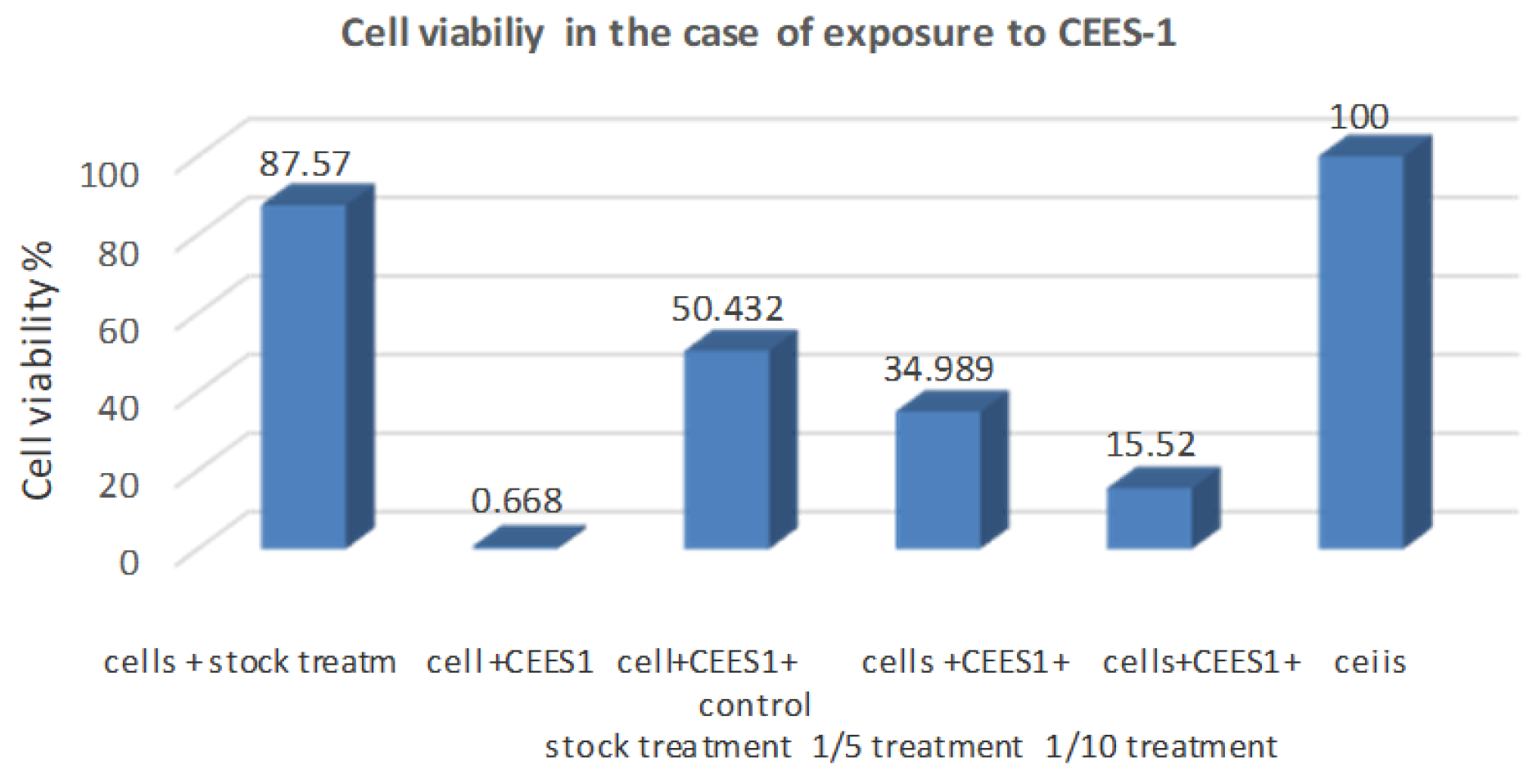
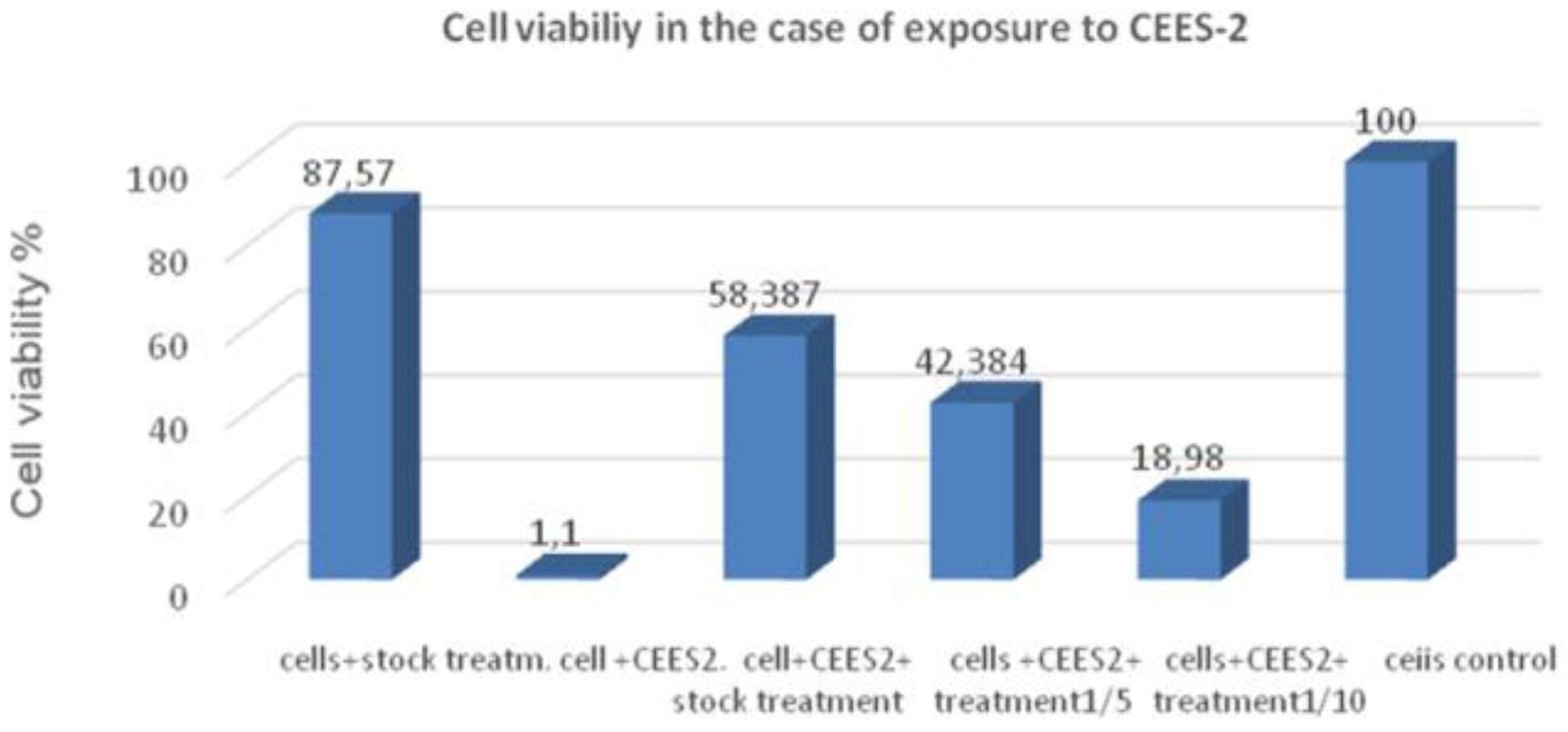

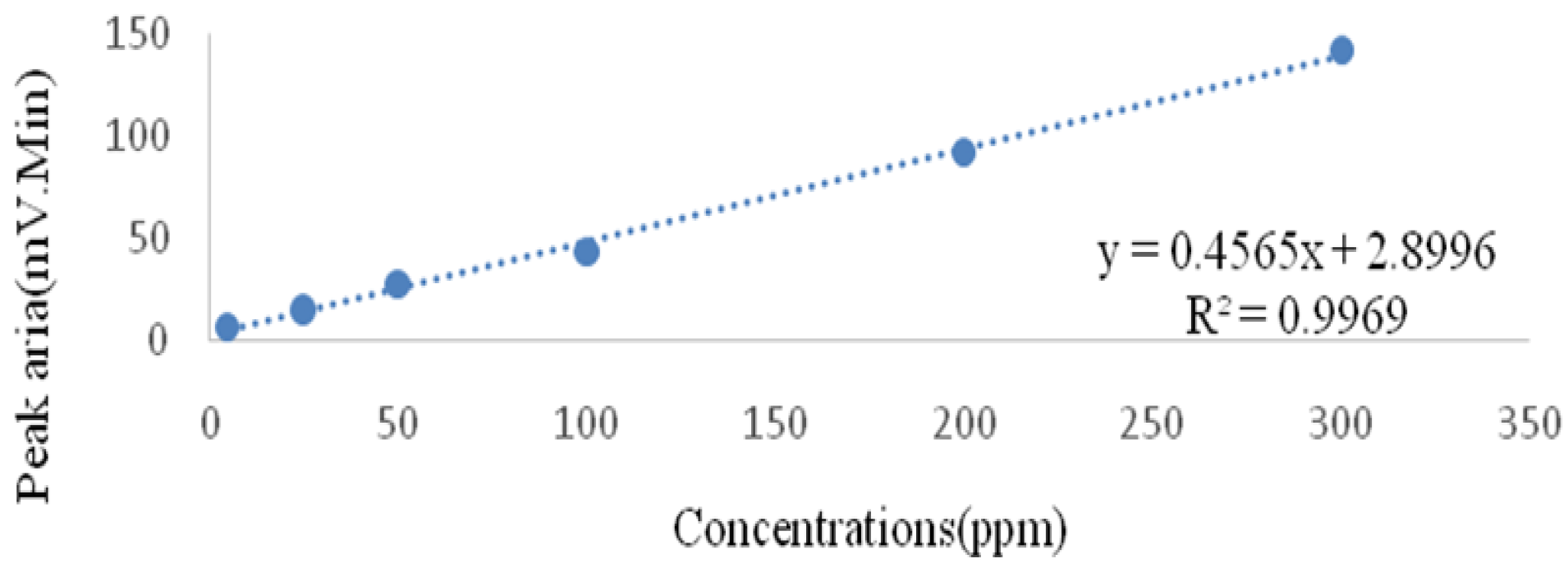
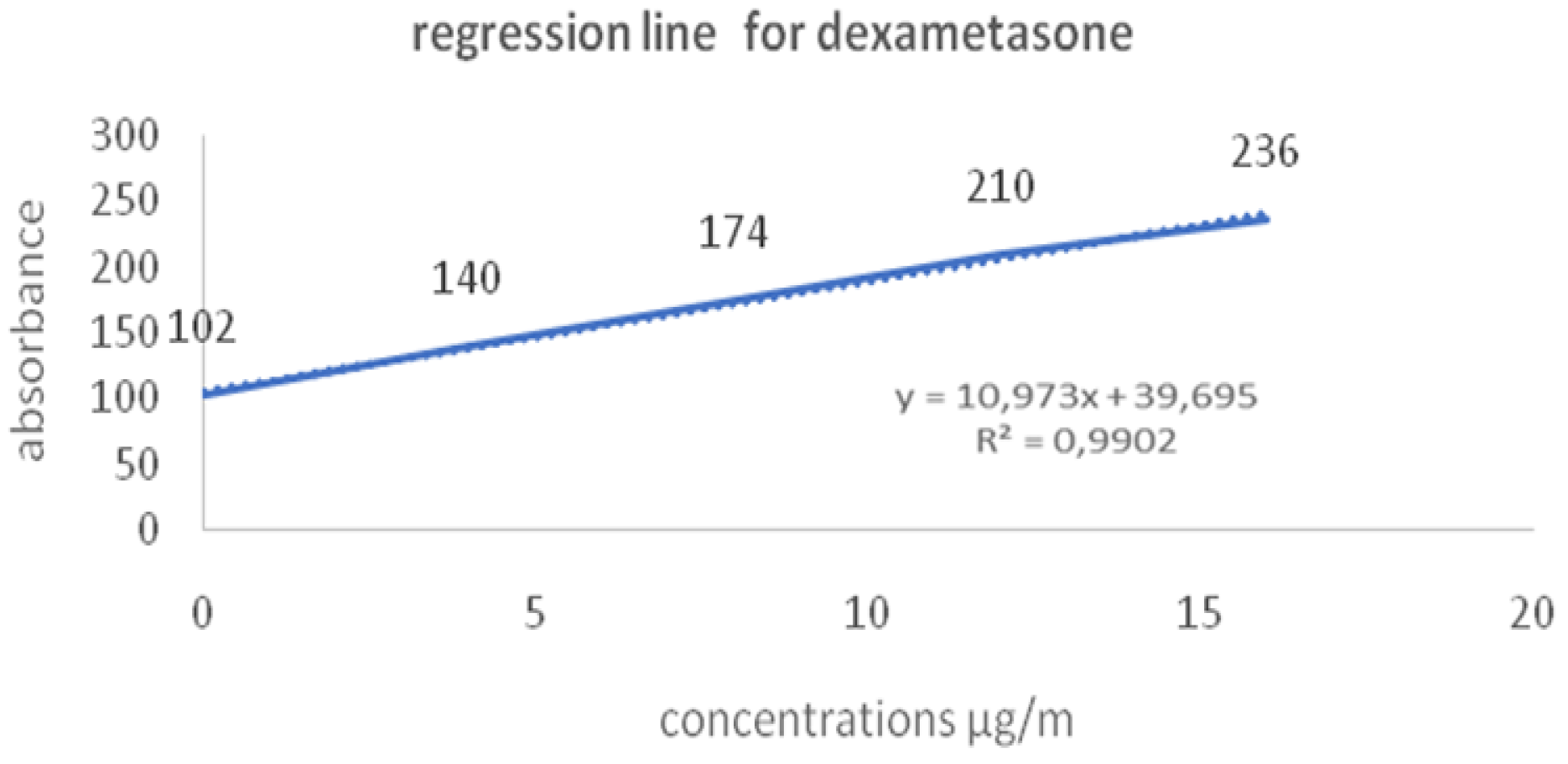
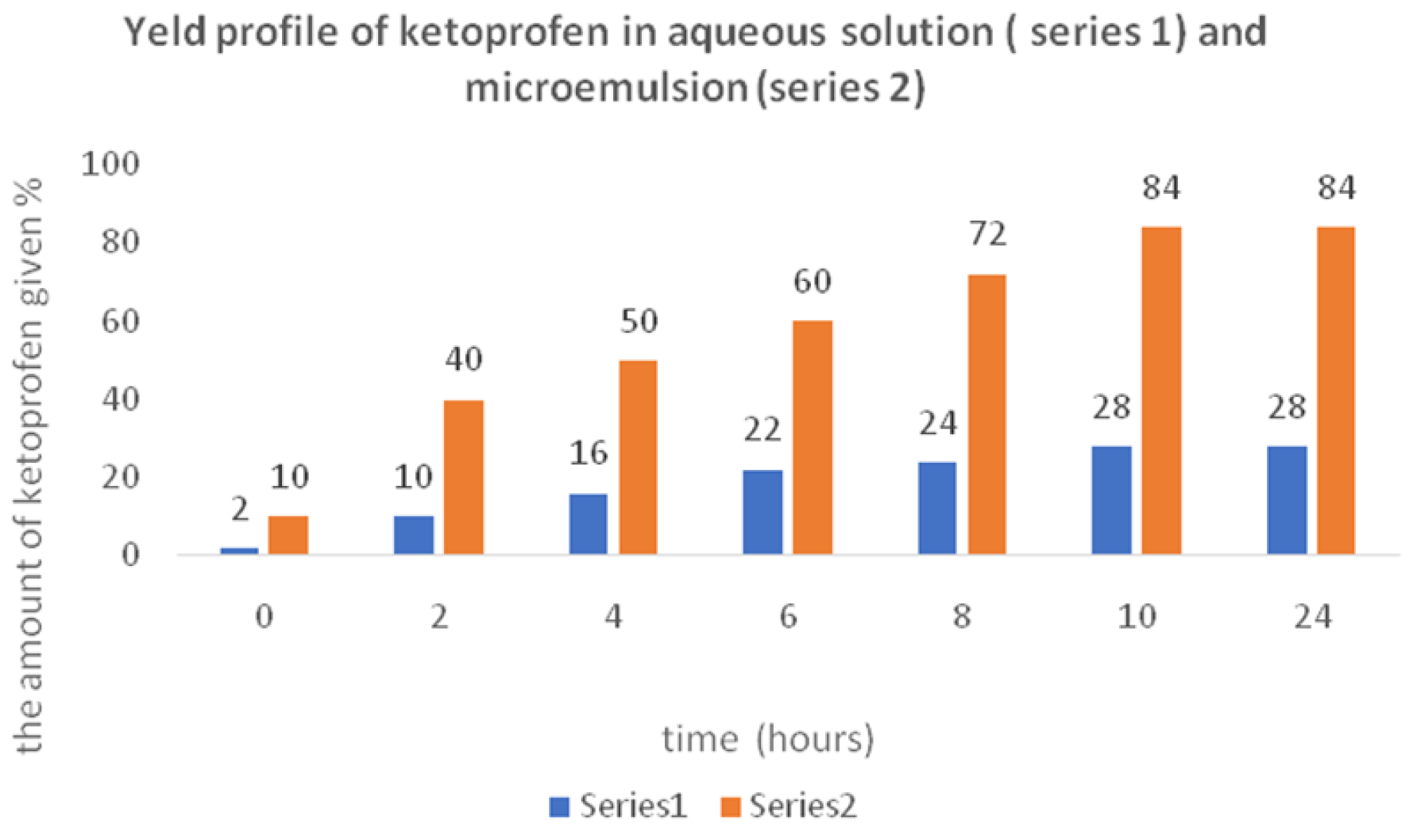
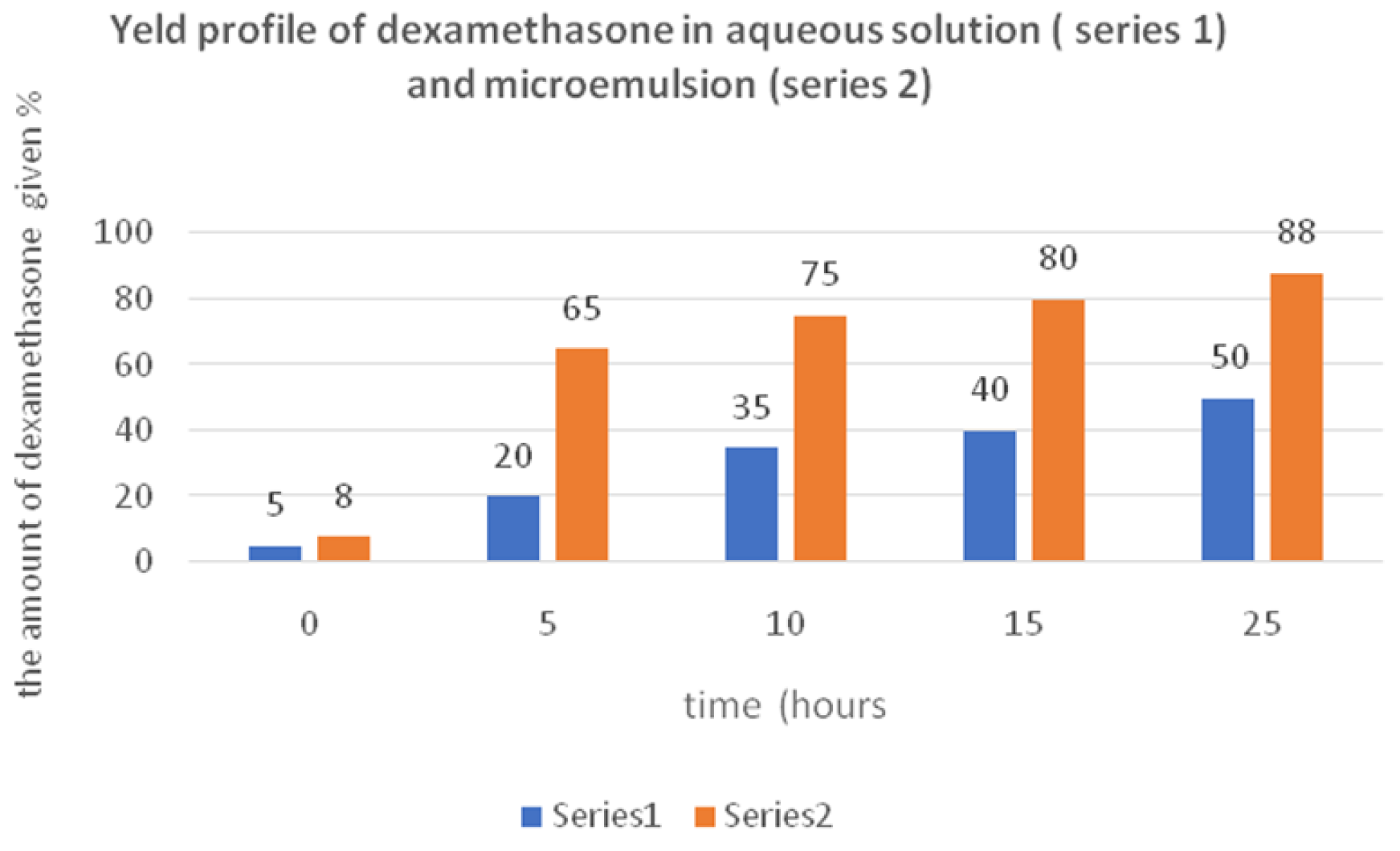
| 1 | 2 | 3 | 4 | 5 | 6 | 7 | 8 | 9 | 10 | 11 |
| Blank | Cells control | Cells + Stock treatment | Cells+ CEES1 | Cells+ CEES1 | Cells+ CEES1+ stock treatment | Cells+ CEES1+ stock treatment | Cells+ CEES1+ 1/5 treatment | Cells+ CEES1+ 1/5 treatment | Cells+ CEES1+ 1/10 treatment | Cells+ CEES1+ 1/10 treatment |
| Blank | Cells control | Cells+ Stock treatment | Cells+ CEES2 | Cells+ CEES2 | Cells+ CEES2+ stock treatment | Cells+ CEES2+ stock treatment | Cells+ CEES2+ 1/5 treatment | Cells+ CEES2+ 1/5 treatment | Cells+ CEES2+ 1/10 treatment | Cells+ CEES2+ 1/10 treatment |
| Toxic | 1 | 2 | 3 | 4 | 5 | 6 | 7 | 8 | 9 | 10 | 11 |
| CEES 1 | 0,054 ±0,0037 | 1,578± 0,067 | 1,389± 0,049 | 0,064 ±0,002 | 0,823 ± 0,004 | 0,587± 0,0025 | 0,291± 0,001 | ||||
| CEES 2 | 0,070 ±0,0015 | 0,944 ± 0,0035 | 0,700± 0,0025 | 0,343± 0,003 | |||||||
| 1 | 2 | 3 | 4 | 5 | 6 | 7 | 8 | 9 | 10 | 11 | |
| CEES 1 | 100 | 87,570±2,67 | 0,668 ±0,05 | 50,432 ± 0,49 | 34,989 ± 0,89 | 15,20± 0,9 | |||||
| CEES 2 | 1,010±0,07 | 50,387± 0,55 | 42,384± 0,98 | 18,980± 0,73 | |||||||
| No. | Control | Average optical density values (nm) | CEES Concentration | P Probability (T test) | Observations |
| 1 | Cells Control | 1,578±0,067 | 0 | 0,002 | < 0,05 |
| 2 | CEES 1 Positive Control | 0,064 ±0,002 | 7,78 *10 -2M |
| No. | Control | Average optical density values (nm) | CEES Concentration | P Probability (T test) | Observations |
| 1 | Cells Control | 1,578±0,067 | 0 | 0,0035 | < 0,05 |
| 2 | CEES 2 Positive Control | 0,070 ±0,0015 | 7,78 *10 -3M |
| No. | Control | Average optical density values (nm) | CEES Concentration | Treatment stock solution (percentage concentration) | P Probability (T test) | Observations |
| 1 | CEES1 Positive Control and treatment | 0,823 ± 0,004 | 7,78 *10 -2M | Acetylcysteine: 10%; Dexamethasone: 4%; Ketoprofen: 5%; | 0,00039 | <0,05 |
| 2 | CEES 1 Positive Control | 0,064 ±0,002 | 7,78 *10 -2M | 0 |
| No. | Control | Average optical density values (nm) | CEES Concentration | Treatment stock solution (dilution) | P Probability (T test) | Observations |
| 1 | CEES2 Positive Control and treatment | 0,944 ± 0,0035 | 7,78 *10 -2M | Acetylcysteine: 10%; Dexamethasone: 4%; Ketoprofen: 5%; | 0,00018 | <0,05 |
| 2 | CEES 2 Positive Control | 0,064 ±0,002 | 7,78 *10 -2M | 0 |
© 2022 by the author. 2022 Cristina Anca Secară, Otilia Liudmila Cinteză, Diana Popescu, Claudia Valentina Popa, Camelia Andreea Hîrjeu, Oana Cristina Voinea, Luiza Georgia Șerbănescu, Andreea Marilena Păuna, Mihail Silviu Tudosie
Share and Cite
Secară, C.A.; Cinteză, O.L.; Popescu, D.; Popa, C.V.; Hîrjeu, C.A.; Voinea, O.C.; Șerbănescu, L.G.; Păuna, A.M.; Tudosie, M.S. Innovative Therapeutic Approach to Chemical Burns Produced by Vesicants; An Experimental Study. J. Mind Med. Sci. 2022, 9, 294-303. https://doi.org/10.22543/2392-7674.1355
Secară CA, Cinteză OL, Popescu D, Popa CV, Hîrjeu CA, Voinea OC, Șerbănescu LG, Păuna AM, Tudosie MS. Innovative Therapeutic Approach to Chemical Burns Produced by Vesicants; An Experimental Study. Journal of Mind and Medical Sciences. 2022; 9(2):294-303. https://doi.org/10.22543/2392-7674.1355
Chicago/Turabian StyleSecară, Cristina Anca, Otilia Liudmila Cinteză, Diana Popescu, Claudia Valentina Popa, Camelia Andreea Hîrjeu, Oana Cristina Voinea, Luiza Georgia Șerbănescu, Andreea Marilena Păuna, and Mihail Silviu Tudosie. 2022. "Innovative Therapeutic Approach to Chemical Burns Produced by Vesicants; An Experimental Study" Journal of Mind and Medical Sciences 9, no. 2: 294-303. https://doi.org/10.22543/2392-7674.1355
APA StyleSecară, C. A., Cinteză, O. L., Popescu, D., Popa, C. V., Hîrjeu, C. A., Voinea, O. C., Șerbănescu, L. G., Păuna, A. M., & Tudosie, M. S. (2022). Innovative Therapeutic Approach to Chemical Burns Produced by Vesicants; An Experimental Study. Journal of Mind and Medical Sciences, 9(2), 294-303. https://doi.org/10.22543/2392-7674.1355



